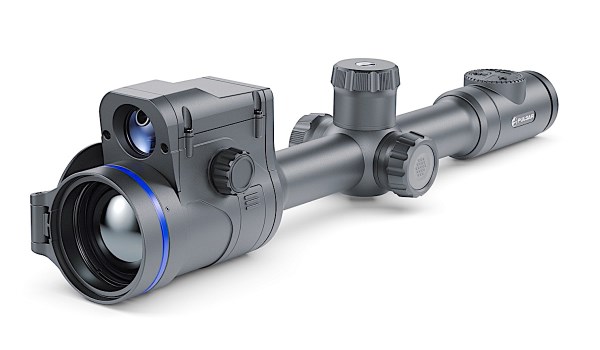
The Pulsar Thermion 2 LRF XP50 Pro is the first choice thermal riflescope for professional pest controllers for efficiently shooting high numbers of pests.
Accurate shot placement is dependent on knowing the distance to your target and understanding the trajectory of your projectile. Modern technology can provide this information with great accuracy for more productive and humane hunting.
Pulsar were first to integrate a laser rangefinder into their LRF product range from 2014 with their Argus LRF Gen2+ and Digisight LRF night vision riflescopes, followed by the Apex LRF thermal riflescope. Since then, Pulsar have continued the development of their laser rangefinder riflescopes and hand-held monoculars with better and faster performance.
Before discussing the merits of LRF hand-held and LRF riflescope, here are some reasons when accurate range finding is important:
• Taking shots at extended distances
• Using low velocity projectiles and crossbow bolts
• Using lightweight projectiles with a steep terminal trajectory
• Shooting small targets
• Shooting at night when relying on a magnified image.
Hand-held laser rangefinding
Many recreational hunters use an optical laser rangefinder to measure target distance, then compensate with hold-over, or adjust their reticle zero to the required distance. Some rangefinders provide additional information such as true horizontal distance and ballistics.

A hand-held thermal imager with an inbuilt laser rangefinder can provide the same information with the advantage of night and poor weather performance. When the distance is known, a Pulsar thermal or digital night vision riflescope has user definable distance settings that are easily dialled-in to move the reticle to provide an accurate pointof-impact.
Riflescopes with laser rangefinding
A laser rangefinder that is built into a riflescope is especially useful for pest control and meat harvesting when target numbers are high. Pest species such as rabbits and wallabies present themselves in large numbers at vastly different distances. Shooting from an ATV or the back of a ute, a great number of pests can be shot in quick succession, increasing productivity and cost effectiveness through a high shot-to-kill ratio. For instance, shooting wallabies at up to 250m with a .223 Rem in the central South Island equates to an operational circumference of 500m.
The latest generation of Pulsar LRF thermal riflescopes have a smart reticle function that automatically adjusts the point of aim using the distance information provided by the inbuilt laser rangefinder. Ballistic profiles are added to the riflescope’s firmware using the Stream Vision 2 app. from a large library of factory loads as well as user definable custom and hand loads.
Pulsar thermal and night vision riflescopes also have multiple user profiles with up to 15 zero distances per profile. These profiles can be used for different ammunition loads, especially useful when using a variety of high velocity and subsonic loads, or when using a crossbow with different types of bolts and tips.
Generally, a hand-held LRF thermal and a non-LRF riflescope is a good option for general hunting. When shooting large numbers of animals, a thermal riflescope with a LRF is highly efficient. Having an LRF function in both hand-held and riflescope provides the best of both worlds, though at a higher investment cost.
For more information about professional thermal imagers, visit:













